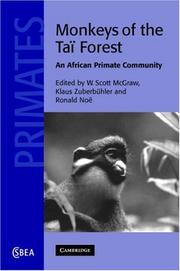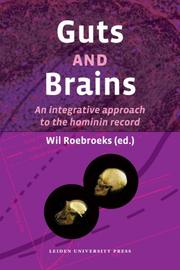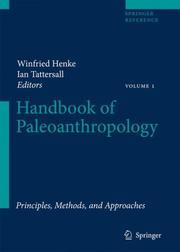| Listing 1 - 4 of 4 |
Sort by
|

ISBN: 9780511542121 9780521816335 9780521016605 9780511286148 0511286147 051128540X 9780511285400 0511542127 1280910038 9781280910036 0521816335 0521016606 0511283806 9780511283802 0511284608 9780511284601 1107159253 9781107159259 9786610910038 6610910030 0511320833 9780511320835 Year: 2007 Publisher: Cambridge, UK New York Cambridge University Press
Abstract | Keywords | Export | Availability | Bookmark
 Loading...
Loading...Choose an application
- Reference Manager
- EndNote
- RefWorks (Direct export to RefWorks)
A great deal has been written about primates; however few volumes have focused on an entire community of sympatric monkeys at a single site. Drawing upon diverse sets of data, the authors provide a multi-thematic case study of the entire monkey community of the Taï forest (Ivory Coast). Much of the book explores how the seven monkey species have adapted to hunting pressures from chimpanzees, leopards, crowned eagles and humans. Other themes covered include feeding ecology, social behaviour, positional behaviour and habitat use, vocal communication and conservation. Colour photographs of all species are provided, showing the major behavioural characteristics of each, as little is known about these West African monkeys. This scientifically important volume will be of interest to a broad audience including primatologists, functional anatomists, psychologists, and behavioural ecologists.
Monkeys --- Cercopithecidae --- Social behavior in animals --- Animal behavior --- Animal societies --- Old World monkeys --- Primates --- Haplorhini --- Behavior

ISBN: 9783791339603 9783791361567 Year: 2007 Publisher: Munich Prestel
Abstract | Keywords | Export | Availability | Bookmark
 Loading...
Loading...Choose an application
- Reference Manager
- EndNote
- RefWorks (Direct export to RefWorks)
Nigeria --- African rock python --- Animals in the performing arts --- Captive wild animals --- Hyenas --- Monkeys --- Nigerians --- Portrait photography --- Threats of violence --- 77.071 HUGO --- documentaire fotografie --- eenentwintigste eeuw --- fotografie --- Hugo Pieter --- portretfotografie --- Violence, Threats of --- Violent threats --- Threats --- Photography --- Portraiture --- Ethnology --- Haplorhini --- Primates --- Hyaenas --- Hyaeninae --- Hyaenidae --- Captive animals --- Wild animals, Captive --- Animals --- Wild animal collecting --- Performing arts --- African python --- Python sebae --- Rock python --- Rock snake --- Python (Genus) --- Portraits

ISBN: 9087280149 9786611787813 1281787817 9048508053 9789048508051 9781281787811 9789087280147 9789087280147 661178781X Year: 2007 Publisher: [Leiden] Leiden University Press
Abstract | Keywords | Export | Availability | Bookmark
 Loading...
Loading...Choose an application
- Reference Manager
- EndNote
- RefWorks (Direct export to RefWorks)
The human brain and its one hundred billion neurons compose the most complex organ in the body and harness more than 20 per cent of all the energy we produce. Why do we have such large and energy-demanding brains, and how have we been able to afford such an expensive organ for thousands of years? Guts and Brains discusses the key variables at stake in such a question, including the relationship between brain size and diet, diet and social organization, and large brains and the human sexual division of labour. This interdisciplinary volume provides an entry for the reader into understanding the development of both early primates and our own species. Waarom hebben wij zulke grote en energie-vretende hersenen? Hoe kunnen we ons zo'n duur orgaan permitteren, en hoe deden Neandertalers dat, hun brein was immers minstens zo groot als dat van de moderne mens? In deze bundel behandelen vooraanstaande onderzoekers de verwevenheid van belangrijke variabelen in deze, bijvoorbeeld de relatie tussen dieet en hersengrootte bij primaten, tussen dieet en sociale organisatie, en tussen grote, "dure" hersenen en de sexe-gebonden arbeidsverdeling bij hedendaagse jagers-verzamelaars. De bijdragen in Guts and Brains laten zien dat kleine veranderingen in het dieet van onze verre voorouders grote gevolgen hadden voor hun manier van leven en uiteindelijk ook voor die van de moderne mens. Daarmee geeft de bundel ons niet alleen een beter inzicht in de levenswijze van vroege mensachtigen maar ook in die van die eigenaardige primaat die wij Homo sapiens noemen, onze eigen soort.
Brain -- Evolution. --- Hominids. --- Human evolution. --- Hunting and gathering societies -- Nutrition. --- Prehistoric peoples -- Behavior. --- Prehistoric peoples -- Food. --- Primates -- Behavior. --- Primates -- Nutrition. --- Genetic Processes --- Nutritional Physiological Phenomena --- Catarrhini --- Investigative Techniques --- Biological Processes --- Central Nervous System --- Biological Phenomena --- Nervous System --- Analytical, Diagnostic and Therapeutic Techniques and Equipment --- Physiological Phenomena --- Haplorhini --- Genetic Phenomena --- Primates --- Phenomena and Processes --- Anatomy --- Mammals --- Vertebrates --- Chordata --- Animals --- Eukaryota --- Organisms --- Biological Evolution --- Brain --- Diet --- Hominidae --- Human beings --- Fossil hominids. --- Origin. --- History. --- Evolution. --- Early man --- Fossil hominins --- Fossil man --- Hominids, Fossil --- Hominins, Fossil --- Human fossils --- Antiquity of human beings --- Origin of human beings --- Health --- Food --- Food habits --- Nutrition --- Human remains (Archaeology) --- Primates, Fossil --- Paleoanthropology --- Human evolution --- archeologie --- archeology --- anthropologie --- homo sapiens --- neandertals --- brains --- anthropology --- Brain size --- Evolution --- Foraging --- Hominini --- Predation --- Primate

ISBN: 3540324747 354033761X 3540338586 Year: 2007 Publisher: Berlin, Heidelberg : Springer Berlin Heidelberg : Imprint: Springer,
Abstract | Keywords | Export | Availability | Bookmark
 Loading...
Loading...Choose an application
- Reference Manager
- EndNote
- RefWorks (Direct export to RefWorks)
Paleoanthropology is perhaps the most multidisciplinary of all the sciences. Any complete account of the evolution and cultural and biological context of Homo sapiens must combine information from geology, paleoecology, primatology, evolutionary biology and a host of other fields. Above all, historical information needs to be combined with, and interpreted in the light of, what we know of the living world. Paleoanthropology is also an actively developing field in which much remains to be settled. The three volumes of this handbook bring together contributions by the world´s leading specialists that reflect the broad spectrum of modern paleoanthropology, thus presenting an indispensable resource for both professionals and students alike. Volume 1 deals with principles, methods, and approaches. In recent years, enormous advances have been made in such areas as phylogenetic analysis, paleoecology and evolutionary theory and philosophy. The contributions in this first volume present the state of the art in these fields, provide succinct introductions to them and reflect the many ways in which they interact. As human beings are primates, Volume 2 is devoted to primate origins, evolution, behaviour, and adaptive variety. Its emphasis is on integration of fossil data with the vast amount that is now known of the behaviour and ecology of living primates in natural environments. Volume 3 deals with the fossil and molecular evidence for the evolution of Homo sapiens and its fossil relatives (the family Hominidae or subfamily Homininae, according to taste, a matter that we have left to the individual contributors).
Paleoanthropology --- Fossil hominids --- Human evolution --- Biological Evolution --- Paleontology --- Hominidae --- Biological Processes --- Anthropology, Physical --- Earth Sciences --- Catarrhini --- Genetic Processes --- Haplorhini --- Genetic Phenomena --- Natural Science Disciplines --- Biological Phenomena --- Anthropology --- Phenomena and Processes --- Primates --- Disciplines and Occupations --- Social Sciences --- Anthropology, Education, Sociology and Social Phenomena --- Mammals --- Vertebrates --- Chordata --- Animals --- Eukaryota --- Organisms --- Evolution --- Physical Anthropology --- Biology --- Health & Biological Sciences --- Paleoanthropology. --- Fossil hominids. --- Human evolution. --- Early man --- Fossil hominins --- Fossil man --- Hominids, Fossil --- Hominins, Fossil --- Human fossils --- Human paleontology --- Life sciences. --- Paleontology. --- Evolutionary biology. --- Anthropology. --- Life Sciences. --- Evolutionary Biology. --- Evolution (Biology) --- Physical anthropology --- Evolutionary psychology --- Human beings --- Human remains (Archaeology) --- Primates, Fossil --- Anthropology, Prehistoric --- Origin --- Evolution (Biology). --- Paleontology . --- Fossilogy --- Fossilology --- Palaeontology --- Paleontology, Zoological --- Paleozoology --- Historical geology --- Zoology --- Fossils --- Prehistoric animals in motion pictures --- Animal evolution --- Biological evolution --- Darwinism --- Evolutionary biology --- Evolutionary science --- Origin of species --- Biological fitness --- Homoplasy --- Natural selection --- Phylogeny --- Fossil Hominids. --- Biological Evolution. --- Hominidae. --- Evolution. --- Origin. --- Methodology. --- Evolution, Biological --- Sociobiology --- Hominini --- Pongidae --- Apes --- Hominids --- Hominins --- Homo --- Ape --- Hominid --- Hominin --- Homininus --- Phylogeography --- Antiquity of human beings --- Origin of human beings --- Taphonomy
| Listing 1 - 4 of 4 |
Sort by
|

 Search
Search Feedback
Feedback About UniCat
About UniCat  Help
Help News
News